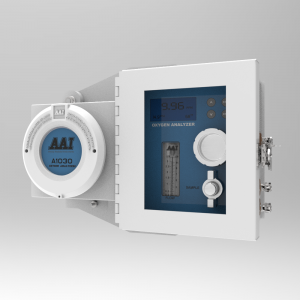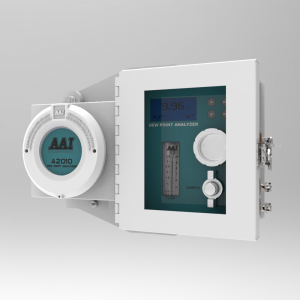Infrared gas analyzer is a physical analysis instrument based on the principle that different gas molecules selectively absorb infrared light at specific wavelengths. It is a typical optical, mechanical and electrical integrated intelligent sensor system. Compared with other gas-sensitive sensor systems, it has the characteristics of high sensitivity, fast response, many types of analysis gas, wide measuring range, and continuous measurement. In the fields of earthquake prediction, mine safety, petroleum exploration, atmospheric physics, medical health, pollution source monitoring, high-voltage equipment fault diagnosis, chemical process control, metallurgy and other traditional industries, as well as all new technologies ** leading disciplines such as biological sciences, microelectronics, New materials and other fields are increasingly used.
Judging from the existing infrared analyzers in China, most of the online monitors need to cooperate with the host computer to complete the post-processing and storage of data. The front end only completes the function of signal detection and acquisition. Supervision (such as pollution source monitoring) cannot be applied. In view of this situation, this paper studies and develops a non-spectral infrared gas analyzer, which can independently complete the monitoring work, and can store data in large-capacity flash memory or remotely via GPRS. Transmission, the instrument ’s simple human-machine interface makes it easy to complete both measurement and instrument calibration. At the same time, the addition of the USB interface makes the instrument have more room for expansion, and the instrument has a variety of signal output methods, which can easily communicate with various System connection.
1 System structure of infrared analyzer
The system block diagram of the infrared analyzer is shown in Figure 1. The TMS320F2812DSP sends a certain frequency modulation signal to control the infrared light source. The infrared light emitted by the infrared light source passes through the gas chamber filled with the gas to be measured and is absorbed by the specific gas. After selective transmission through the filter, it reaches the corresponding infrared detector. The detector measures the intensity of the absorbed light energy. It reflects the intensity of the infrared light absorbed by the gas, and also reflects the concentration of the gas. The weak signal output by the infrared detector passes a precise pre-amplification and secondary amplification filter circuit to obtain a stable signal. After the signal is A / D converted, it is sent to the DSP for analysis and processing. After filtering and non-linear correction, * final The measured data will be transmitted, saved, or refreshed according to the system settings and the current instrument status. Note that there are at least two measurement channels in the detector. Among them, one is the measurement channel and the other is the reference channel. This can achieve the effect of differential measurement and suppress the system noise and interference. Road sensors and A / D channels are used to measure temperature, humidity and gas pressure, and participate in the compensation calculation of concentration.
2 System hardware design
In the hardware design of the instrument, the choice of infrared light source, detector, DSP system and peripheral circuits, and signal amplification circuit is the key. The infrared light source of this instrument is the IRL715 infrared light source. The wavelength range of the light source is from the visible light wavelength to 5 μm. The working life can be up to 40 000 h under 5 V voltage drive. The detector selected TPS2534G2 with two measurement channels. The DSP uses the TMS320F2812 digital signal processor from the American TI company. It provides a 32-bit fixed-point DSP with a core of up to 150 MIPS of computing bandwidth, which greatly improves the control accuracy and data processing capabilities of the control system. Switch output, man-machine interface. Storage system and USB communication interface. The signal amplifier circuit uses two-stage AD8552 op amp circuits in series. The AD855X series has the function of automatic offset adjustment, which is the best choice for low-frequency weak signal detection amplifier systems. Because this instrument focuses on the application of high-speed DSP systems to infrared analysis instruments, the following describes the peripheral circuits of the DSP.
2.1 Data acquisition
Data acquisition is mainly responsible for analog-to-digital conversion and signal acquisition, passing various analog quantities that need to be measured. A / D is sent to DSP after conversion. The signals of the measurement channel and the reference channel are generated by an infrared detector and converted by an A / D converter with a conversion accuracy of 16 bits. A serial 16-bit A / D converter that can directly interface with TMS320F2812 is selected according to requirements; The signals participating in the gas concentration compensation calculation, including humidity, temperature, and atmospheric pressure signals, are time-converted by the A / D of the TMS320F2812, with a conversion accuracy of 12 bits. The above signals are sent to the DSP processor buffer after conversion. After a series of complicated calculations, the concentration value of the measured gas is finally obtained. Here is given the circuit design for the measurement channel and reference channel signal acquisition, as shown in Figure 2.
2.2 Switch output
On-off output mainly includes detector temperature control signal, optical lens window temperature control signal, element alarm trigger signal (concentration, temperature, humidity) 3 and 1 time trigger signal. The digital I / O port of the DSP processor can be used to realize digital output, and the 74HC244 can realize the drive output of each control signal. Figure 3 is a digital output circuit diagram. It should be noted that the power supply voltage of the TMS320F2812 processor is 3.3 V, and the power supply voltage of the 74HC244 is 5 V. The two devices have level conversion problems with the interface circuit and cannot be directly connected. To achieve level matching between TMS320F2812 and 74HC244.
2.3 Human-machine interface
The human-machine interface uses the LCMl68651 liquid crystal module as a display and an interrupted matrix keyboard. The task of the human-machine interface is mainly to receive keyboard instructions, complete instrument settings, calibration, measurement and other operations, and provide real-time concentration change curve drawing, and Provides query and display functions for historical data.
2.4 USB interface circuit
USB interface is used for communication between lower computer and upper computer. The data transmission rate of USB is very high, so it can not only be used to transmit commands, but also transmit data in real time, including the original measured value, current concentration value, or historical record value. Figure 4 shows the schematic diagram of the USB interface circuit.
2.5 Data storage
The data that the infrared analyzer needs to store includes: gas measurement record number, date, time, concentration value, temperature, humidity, atmospheric pressure, etc. The amount of recorded data depends on the size of the saved item, the type of storage, the frequency of storage, and the length of time Taking into account the requirements of online measurement and unmanned measurement, a large-capacity flash memory K9F1G08UOA is used as the data storage medium of the instrument, and the total data storage capacity is greater than 128 MB.
3 System software design
The quality of the software processing directly determines the processing speed of the system and the accuracy of the calculation results. Figure 5 shows the main flow of the instrument software. The basic principle is to use a ring buffer to buffer the data and other information, without affecting the system. High-speed measurement and data transmission can be achieved under the circumstance of machine-computer interaction. Throughout the software’s entire processing process, * time consuming is also * the place that affects performance is the processing of raw data, which involves filtering, environmental and detector compensation correction, and elimination of gas absorption cross interference and other algorithms. These algorithms in this instrument Special optimizations have been made for the DSP to ensure the rapid operation of the system.
The system first completes initialization, including initializing the DSP and its peripheral circuits, creating and setting the original data, the target data, the circular buffer of the keyboard and other information, and so on. Set the modulation frequency of the infrared light and start it. The meter enters the waiting state. The user can set the parameters of the meter at this time. Pressing the key or the remote start command will make the meter enter the measurement state. In the measurement state, the meter sequentially judges whether there are data or commands to be processed, and then performs corresponding processing, such as remote command execution, raw data calculation, key command execution, target data transmission and storage, LCD interface refresh, etc.
A variety of raw data will be read by the interrupted program and stored in the raw data ring buffer according to the set sampling rate. The raw data includes the readings of the measurement channel and reference channel, various compensation signals, and measurement time. Raw data is used after processing. The calculated target value is put into the target data buffer. If the system has settings for transmission, display or saving, the data in the target data buffer will be used in turn. All ring buffers maintain their own read-write pointers and modify them after the corresponding operations are completed. Some higher-priority commands and special cases are not restricted by the above processes. Operations such as stop commands will be processed directly in the interrupt.
4 Experimental results
The specific types of gases measured by this instrument have not been mentioned in the previous article, because the instrument can be used to measure the concentration of multiple gases, such as CO2, when the filter is replaced with filters of different wavelengths and the corresponding parameters are modified. , CO and HC. In the experiment, CO2 was selected as the test gas type. At an ambient temperature of 25 ° C and a standard atmospheric pressure, a variety of standard concentration CO2 gases qualified by the national metrology department were measured with this instrument. The actual results show that the error is ** 0.3%, the relative error is within 2%, and has better measurement accuracy.
5 Conclusion
Infrared gas analyzer involves multi-disciplinary fields such as optics, mechanics, electronics, computer, communication, information fusion, etc. The requirements for the design and integration of software and hardware are relatively high. The infrared gas analyzer described in this article relies on the powerful computing power of SP It not only meets the requirements of high-speed measurement, but also greatly enhances the portability and installation of the instrument because it is separated from the host computer. Through on-site operation and debugging, many advantages of the instrument have been demonstrated, such as simple and reliable structure, and convenient installation and maintenance. , Convenient operation, can save data for a long time, USB extension, etc. It is believed that with the replacement of the online gas analyzer, the application prospect of this instrument is getting wider and wider.
View more oxygen analyzer at www.avcray.com.




